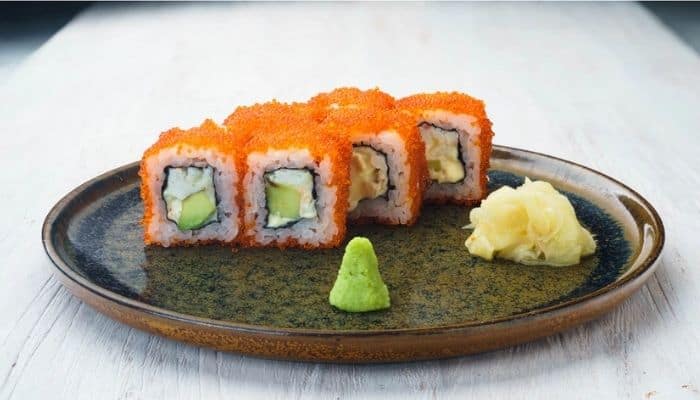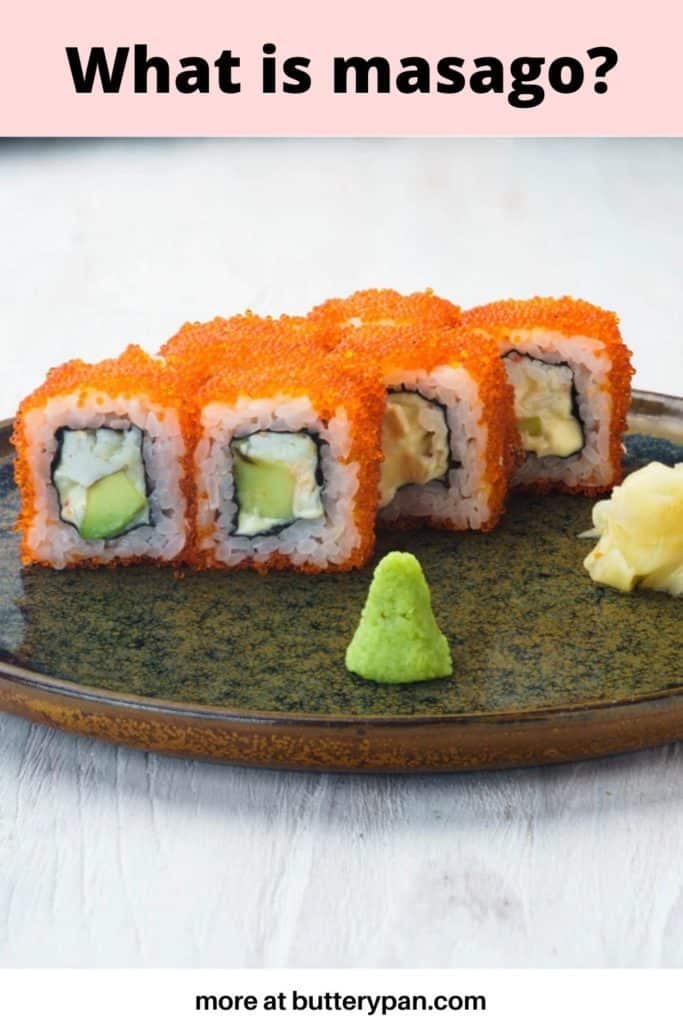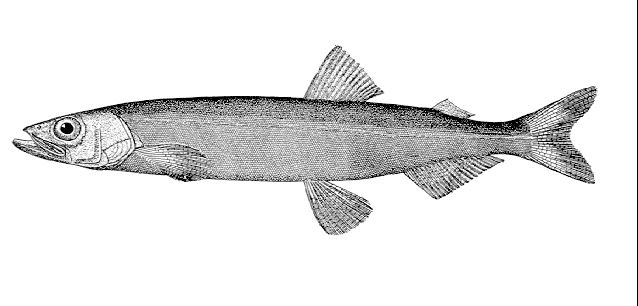What Is Masago? How to eat it?

What is masago in sushi? Masago is a type of fish roe that is used on top of sushi, sashimi, and other types of Japanese food.
It resembles tiny orange beads and gets its color from being made with the swim bladder or air bladder (called “masago”) from an immature female salmon. If you’re looking for what masago is and what it tastes like, this blog post has all the answers!
Table of Contents
What is masago?
Masago is what you see in the bright orange chunks of fish roe on top of sushi and other Japanese food. It’s made from an immature female salmon, which is what gives it its color. Masago are tiny little beads that when eaten burst with a tangy flavor.
Masago comes from what is known as a fish’s swim bladder or what some call the air bladder. This tiny organ that sits just below and behind the gills of most fishes typically functions to aid in buoyancy but also helps them breathe by regulating the pressure within their body.
In salmon, for example, it can grow up to four times larger than what they are themselves.
Masago history is is a mystery that has been debated for centuries, but what most agree on is that this little fishy delicacy was born out of an accident and not intended by man or nature.
Masago comes from the Engraulis japonicus or Anchovy fish, a small schooling fish that is often found in the waters of Japan.
The Anchovy’s swim bladder grows to be what will eventually become Masago as they develop during their larval stage and when harvested, it has been described as looking like “an iridescent pearl onion.”
The flavor of masago varies depending on its age but typically there are three different types:
Fresh (younger)
Sweet and buttery with what some describe as an almond nuttiness;
Semi-dried or dry cured (older)
Richer/ smokier/ saltier notes with what others would say have more depth;
Salted dried or fermented
Well-balanced flavors without any strong salty taste.

What does masago mean?
What is masago in Japanese, and what does it mean? The word “masago” means “roe with salt” in Japanese.
In the United States, and other countries masago is frequently referred to as ikura (salmon eggs).
What is masago in sushi?
Masago in sushi is a type of fish roe converting your sushi. Masago is what some would say is the “pink caviar” in sushi and it tastes a little bit sweeter than other types of salmon eggs or trout eggs, with what some describe as an almond nuttiness.
What is Masago used for?
Its most common use outside of Japan is to add flavor when making sushi or other types of raw fish dishes. Masago is often used in sushi restaurants to make what’s called a “chum salmon roll,” where masago and chum salmon are laid out on top of rice or wrapped with seaweed.
Masago has also been known to be used as an addition for eggs Benedict because it gives the dish some pop amongst its other flavors.
Also, masago can be used as a topping for salads, noodles or rice dishes.
In Russia masago (or ikra, as it is referd to) is frequently used in what is called blini, which are a type of thin pancake.
How do you eat masago?
This question can be answered by what it is being used for.
In sushi form it’s eaten as-is with chopsticks or using the hand to put pieces into your mouth and chew them up before swallowing.
As an egg topping it’s incorporated whole eggs onto dishes like omelets or scrambled eggs – but these are not common outside of Japan due to the fish flavor ceasing to exist when heated past 130°F.
Masago typically does not have much taste on its own, however, so some people find that adding salt or soy sauce will help boost flavors while eating this food item; others suggest that you could also add wasabi paste to the masago before you eat it.
Masago can be eaten without any preparation at all if you want to save time and just go straight for eating raw – this could be done by spreading some on top of your favorite sushi.
Be aware that what people refer to as “masago” might not necessarily mean what we’re talking about here; there’s another product called tobiko.
Masago vs Tobiko
The main difference between masago and tobiko is what they are made of. One is fish bladder (masago), and the other is flying fish roe (tobiko).
Masago also has a different flavor – it’s slightly mellower and creamier than what tobiko will usually taste like, for whatever reason.
Taste-wise, both products are similar in that they’re salty with a tangy edge to them; some people even say masago tastes faintly sweet!
Some people might be wondering what separates this ingredient from sushi seasoning or wasabi paste? In short: not much! Some may find one preferable over the others depending on their personal preference, but all three can complement your favorite sushi dish.
What does masago taste like?
Masago doesn’t have much flavor on its own but what it lacks in being flavorful is made up by what it can add to other foods. Masago has been known to provide an unctuous and buttery texture that makes the taste so special.
What is masago sauce
Masago can be also used to prepare a sauce that goes with sushi. The taste of the masago can be turned into what you want it to taste like by adding in things such as soy, ginger and horseradish for spicy flavors.
Masago sauce tastes like what you would expect a sushi sauce to taste like… 🙂 If what you are looking for is the fishy flavor masago does not deliver that, it can be added in later on but what it will give your food is an unctuous butter texture.
Masago has been producing primarily from Japan and China with some coming from Indonesia as well but what they all have in common when being produced is just how fresh each one of them must stay until consumption.
Fish bladders were used because they held pure liquid while at the same time keeping out impurities
What is smelt roe and capelin?
Smelt roe is what masago is made from, it also goes by the name ikura or salmon roe. – it is a type of fish.
Capelin is also a species of fish, that is used to get masago.
It’s a type of smelt with ikura in the north Pacific Ocean near Alaska, Russia, and Japan as well as off the coast of California. – it lives for an average three years but can reach up to seven years old.
Capelin eggs are what is used for what is masago rather than roe because they’re bigger and easier to eat so more people like them better.
Is salmon roe same as masago?
No, salmon roe is what ikura or salmon roe comes from. It’s the eggs of a type of Pacific fish that live in saltwater close to Alaska and Japan but also off the coast of California. – it lives for an average of three years but can reach up to seven years old.
Smelt roe is what masago is made from, it also goes by the name ikura or salmon roe. – it is a type of fish. It typically has caviar inside as well because they’re higher quality than what you get with capelin eggs which are what masago usually comes from nowadays anyways.”

What are masago eggs?
Masago eggs are what is masago made from.
It’s what is the roe of the capelin (or smelt roe) and they’re what ikura are usually called in English-speaking countries. It can range from a dark red to light pinkish color depending on how ripe it is when harvested with mature being more reddish than unripe.
Types of masago
There are many different types of masago available on the market – some have a more salty flavor while others are sweeter.
Here are some of the types that you can frequently come across :
– The standard type is what’s most readily available in the supermarket. It has a mild saltiness and what is the color that ranges from light pink to dark red depending on how ripe it is when harvested with mature being more reddish than unripe.
– Akami – this one might not be as common but what you’ll usually find are small, thin fillets of masago with plenty of what is roe still attached to what is a meaty part. They have a stronger salty flavor but some people don’t like them because they’re chewy and hard to eat unless dipped in soy sauce or wasabi paste before consumption.
– Hama hama – these types tend to be smaller than akami ones
Blue Masago
Blue masago is what we call the type of masago that has a more blue color because it is what comes from the male fish.
Orange Masago
This is what you get when you find female and male fish, so therefore this isn’t what’s traditionally used for sushi but instead can be purchased as an available topping at any Japanese grocery store or Asian grocer.
Black Masago (Shiroi Ebi)
It doesn’t look like much, but black masago typically looks like little strips of paper with white dots on them. This variety of fillet tastes just as salty and tasty as all others!
How to choose masago?
One way to tell if you’ve bought good quality masago is by checking for bright orange coloration and firmness when it’s still fresh out of the package. The what is roe should also be what is bright, what is meaty part should not have any cracks and the what is skin will typically feel slimy.
Masago comes in a variety of colors such as red (akami), pinkish-red (hama hama), or even white with black stripes on what’s outside layer but they all pretty much taste the same: salty and tasty! This type of fish fillet has been used for centuries to create sushi toppings because it adds flavor while also adding that crunch texture you find in sashimi.
How to use masago?
if you want to use masago raw, store it in the fridge at room temperature until just before using time so that it doesn’t become too hard and lose its natural taste. You
Masago Nutrition Facts
One serving size (which equates to about four pieces) contains only 15 calories and less than one gram of fat but lots of protein with 11 grams per serving. That means this type of fish fillet will be filling without giving you extra weight!
Conclusion
Now you know everything about what is masago! It’s most commonly used to top your favorite sashimi or nigiri, but it also goes great with other Japanese dishes like tempura and ramen.
If you live near an Asian supermarket chain, they might carry masago for sale as well! Have you ever tried this popular ingredient? What are some ways you use it in your cooking at home? Let us know about how using masago has changed the way you enjoy eating Japanese food!